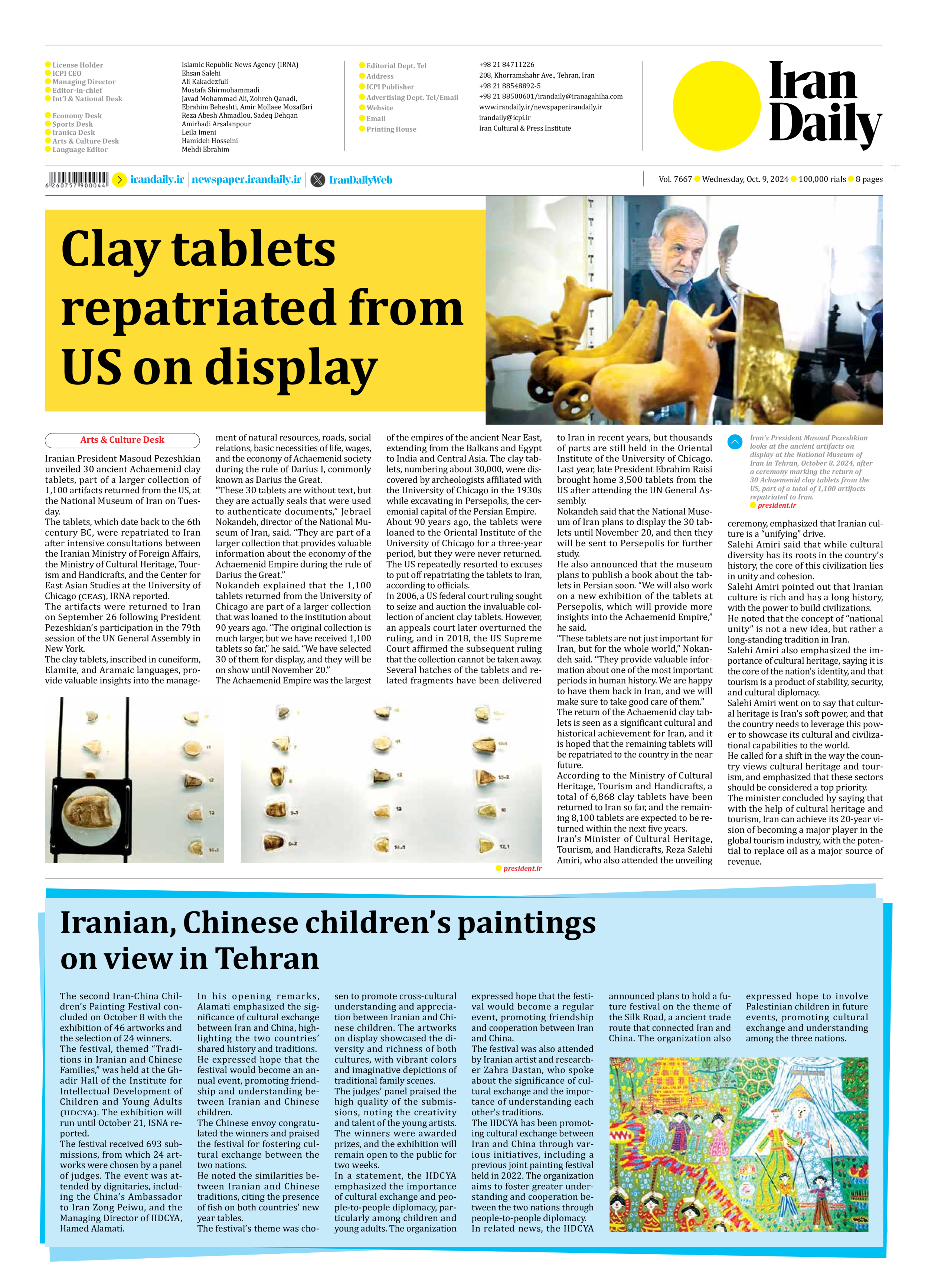
Clay tablets repatriated from US on display
Iranian President Masoud Pezeshkian unveiled 30 ancient Achaemenid clay tablets, part of a larger collection of 1,100 artifacts returned from the US, at the National Museum of Iran on Tuesday.
The tablets, which date back to the 6th century BC, were repatriated to Iran after intensive consultations between the Iranian Ministry of Foreign Affairs, the Ministry of Cultural Heritage, Tourism and Handicrafts, and the Center for East Asian Studies at the University of Chicago (CEAS), IRNA reported.
The artifacts were returned to Iran on September 26 following President Pezeshkian’s participation in the 79th session of the UN General Assembly in New York.
The clay tablets, inscribed in cuneiform, Elamite, and Aramaic languages, provide valuable insights into the management of natural resources, roads, social relations, basic necessities of life, wages, and the economy of Achaemenid society during the rule of Darius I, commonly known as Darius the Great.
“These 30 tablets are without text, but they are actually seals that were used to authenticate documents,” Jebrael Nokandeh, director of the National Museum of Iran, said. “They are part of a larger collection that provides valuable information about the economy of the Achaemenid Empire during the rule of Darius the Great.”
Nokandeh explained that the 1,100 tablets returned from the University of Chicago are part of a larger collection that was loaned to the institution about 90 years ago. “The original collection is much larger, but we have received 1,100 tablets so far,” he said. “We have selected 30 of them for display, and they will be on show until November 20.”
The Achaemenid Empire was the largest of the empires of the ancient Near East, extending from the Balkans and Egypt to India and Central Asia. The clay tablets, numbering about 30,000, were discovered by archeologists affiliated with the University of Chicago in the 1930s while excavating in Persepolis, the ceremonial capital of the Persian Empire.
About 90 years ago, the tablets were loaned to the Oriental Institute of the University of Chicago for a three-year period, but they were never returned. The US repeatedly resorted to excuses to put off repatriating the tablets to Iran, according to officials.
In 2006, a US federal court ruling sought to seize and auction the invaluable collection of ancient clay tablets. However, an appeals court later overturned the ruling, and in 2018, the US Supreme Court affirmed the subsequent ruling that the collection cannot be taken away.
Several batches of the tablets and related fragments have been delivered to Iran in recent years, but thousands of parts are still held in the Oriental Institute of the University of Chicago. Last year, late President Ebrahim Raisi brought home 3,500 tablets from the US after attending the UN General Assembly.
Nokandeh said that the National Museum of Iran plans to display the 30 tablets until November 20, and then they will be sent to Persepolis for further study.
He also announced that the museum plans to publish a book about the tablets in Persian soon. “We will also work on a new exhibition of the tablets at Persepolis, which will provide more insights into the Achaemenid Empire,” he said.
“These tablets are not just important for Iran, but for the whole world,” Nokandeh said. “They provide valuable information about one of the most important periods in human history. We are happy to have them back in Iran, and we will make sure to take good care of them.”
The return of the Achaemenid clay tablets is seen as a significant cultural and historical achievement for Iran, and it is hoped that the remaining tablets will be repatriated to the country in the near future.
According to the Ministry of Cultural Heritage, Tourism and Handicrafts, a total of 6,868 clay tablets have been returned to Iran so far, and the remaining 8,100 tablets are expected to be returned within the next five years.
Iran’s Minister of Cultural Heritage, Tourism, and Handicrafts, Reza Salehi Amiri, who also attended the unveiling ceremony, emphasized that Iranian culture is a “unifying” drive.
Salehi Amiri said that while cultural diversity has its roots in the country’s history, the core of this civilization lies in unity and cohesion.
Salehi Amiri pointed out that Iranian culture is rich and has a long history, with the power to build civilizations.
He noted that the concept of “national unity” is not a new idea, but rather a long-standing tradition in Iran.
Salehi Amiri also emphasized the importance of cultural heritage, saying it is the core of the nation’s identity, and that tourism is a product of stability, security, and cultural diplomacy.
Salehi Amiri went on to say that cultural heritage is Iran’s soft power, and that the country needs to leverage this power to showcase its cultural and civilizational capabilities to the world.
He called for a shift in the way the country views cultural heritage and tourism, and emphasized that these sectors should be considered a top priority.
The minister concluded by saying that with the help of cultural heritage and tourism, Iran can achieve its 20-year vision of becoming a major player in the global tourism industry, with the potential to replace oil as a major source of revenue.







